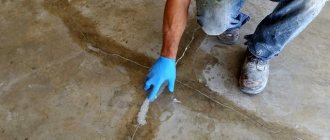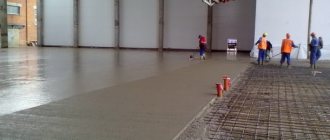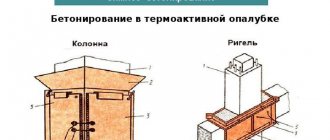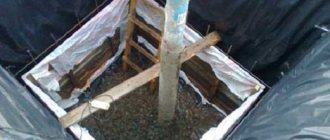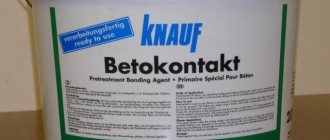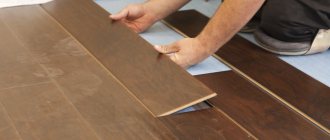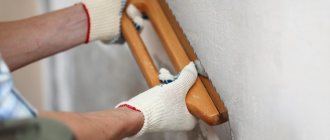Types of defects in concrete floors
Defects in concrete floors can be divided according to the following indicators:
- Defects obtained during concrete installation:
- shrinkage cracks;
- cracks due to design and technological errors.
- Destructions acquired during operation:
- potholes;
- delamination;
- chips;
- deep cracks.
Shrinkage cracks in concrete mortar
What you need to know about concrete? This is a multicomponent solution in which chemical reactions occur. The main chemical reaction of concrete mortar is hydration between the cement stone and water, as a result of which the plastic mixture turns into durable stone. These processes are characterized by internal stress of the structure.
The first shrinkage cracks may appear on the concrete surface in the first 6-8 hours after pouring, as it contracts, releasing moisture. Cracks may also appear during the further period of strength gain. What can affect the appearance of cracks:
- Incorrect proportions of concrete mortar components:
- excess water;
- excess cement;
- absence of plasticizers and others.
- Incorrect initial care of the setting mixture. Moisture should not leave the solution too quickly:
- if 10% of the moisture evaporates in a short period of time, then 18% of the strength of concrete is lost;
- if 20% moisture, then 30% strength;
- if 30% moisture, then 50% strength.
Therefore, the solution is protected from drafts and direct sunlight. To do this, the surface is moistened and tightly covered with film. In general, small shrinkage cracks (hairline cracks) are normal for concrete, but their width should be no more than 0.1 mm.
Why they appear inside a brick house: where to go
The most common cause of cracks in a brick house is its shrinkage.
In addition, the builders, who made mistakes in construction technology, did not give the foundation time to stand during one winter period. As a rule, it is for these reasons that splits occur in the wall, which are important to eliminate in a timely manner.
Kawabanga! Technical characteristics of sand concrete M200
When flaws appear, they need to be “treated.”
And for this you need to decide: where to turn for help?
Design and technological errors
Structural errors are the incorrect selection of the floor structure, that is, its concrete component. As a rule, these are errors at the design stage, when loads, groundwater levels, base composition and temperature differences are incorrectly taken into account.
They may be as follows:
- Construction of a concrete floor (screed) of small thickness without reinforcement on a weak base - soil or insulation.
- Installation of a concrete layer on a wooden base.
- The process of frost heaving of the soil of a concrete floor base.
Technological errors are characterized by ignorance of the features of the concrete layer as a material. The most common mistake concerns failure to take into account the thermal expansion of concrete. To combat expansion, damper tapes are laid near walls, partitions and columns, and expansion joints are installed on the concrete sheet itself.
Expansion joints in concrete are cut after the concrete has gained sufficient strength to a depth equal to 1/3 of the thickness of the concrete layer. It is recommended to cut expansion joints every 1.2-1.5 m in large production areas, but you can do without them in small living rooms.
The purpose of expansion joints is that they control the chaotic nature of the appearance of cracks. In this case, it is possible to carry out periodic repairs of the seams, rather than opening many small cracks.
Concrete floor repair technology
Repairing a concrete floor is a strict technological process that is subject to SNiP standards. Restoration of surfaces is required to eliminate corrosion processes, ensure chemical passivity of artificial stone, eliminate cavities and porosity. During the repair work, the appearance of the surface is restored and conditions are provided that prevent water from penetrating into the concrete.
Destruction during operation
The concrete floor is subject to the following types of loads:
- Static. They represent constant loads from furniture, shelving, and stored material. Characterized by the appearance of cracks.
- Abrasive. They arise from friction with other materials. Lead to surface destruction of concrete.
- Dynamic. Loads from moving people and vehicles, shock loads. serious damage occurs: potholes, chips.
- Vibrating. For example, vibration of turning and metalworking equipment. Appearance of cracks.
- Chemical. Exposure to various aggressive liquids. They disrupt the structure of the material.
As a rule, for industrial concrete floors this is a complex of all types of loads: pressure and vibration from process equipment, from the wheels of loading equipment, the impact of temperature changes (especially in unheated rooms).
Over time, concrete corrodes, not as quickly as metal, but chemical processes also occur in it that violate the integrity of the material:
- With constant contact with precipitation and groundwater, the easily soluble component, slaked lime, is gradually washed out of concrete.
- The destructive effect of mold, fungi and other microorganisms.
- Exposure to aggressive liquids that lead to an increase in concrete volume.
Other reasons for the destruction of concrete can be stray currents, seismic activity of the soil, climatic features: sea wind, sudden changes in heat and cold, and others.
Types and causes of cracks in walls
Wall cracks can be classified by dividing them into groups:
- Due to: shrinkage, deformation, temperature, structural, as well as those arising from wear or weathering of walls.
By destruction: shearing, crushing and rupture.
Direction: inclined, vertical and horizontal.
By outline: curved, straight and closed (not touching the edges of the walls).
By depth: through and surface cracks.
According to the degree of risk: dangerous and not dangerous.
By time: stable and unstable cracks.
Kawabanga! How to calculate the price of building a house from foam concrete blocks
- By opening size: large - more than 1 mm, small - up to 0.3 mm, hair - up to 0.1 mm, developed - up to 0.5 mm.
The main causes of cracks in walls can be:
Impact of surface loads
. They can arise from storing industrial raw materials, building materials or products near walls. The impact of such loads causes compression of the soil and settlement of the foundation, causing cracks.
Temperature deformations
. They can cause cracks if the building is long and there are no expansion joints. Damage in this case occurs in the middle part of the structure, the cracks have a vertical direction.
Fighting small cracks
What to do if a freshly concreted floor is covered with a network of small cracks? Although their presence is quite natural, during the operation of the floor, moisture may enter the cracks, and temperature changes will lead to the deepening and expansion of defects. Even if the concrete layer serves as a floor screed in a residential area, where temperature changes and moisture access are not expected, and it is located under the floor covering layer, various force majeure circumstances may still arise.
There is an interesting technology for self-healing cracks. The manufacturer of waterproofing materials Penetron suggested adding Penetron Admix while mixing the concrete mixture. The material was originally used to maintain strength, water resistance and chemical resistance. But it was noticed that if moisture is added to small cracks up to 0.4 mm thick that appear in concrete with a modified additive, then within a few days they heal (overgrow with crystals).
Please note: such repairs are possible if Penetron Admix is added at the concrete preparation stage. You can add the material dissolved in water to the mixer transporting the ready-mix concrete.
Other treatment methods for cracks
Before you begin treating cracks, they need to be widened. Various tools are suitable for this:
- Electrical equipment (grinder, drill, grinder).
- Common plumbing tools (knife, shovel, trowel, spatula, wire brush, chisel, chisel, hammer).
- Additional equipment (paint brush, ruler, vacuum cleaner).
The following methods are used to seal cracks:
- injection;
- filling (surface filling).
For injection into a deep crack, inclined holes are drilled on both sides in a checkerboard pattern, into which tubes are installed. The filling solution is pumped into the tubes under pressure, then the tubes are removed. Surface filling is suitable for shallow, widened cracks.
Depending on the materials used, the following classical types of crack filling differ:
- Silication.
- Bituminization.
- Smolization.
- Cementation.
Silication
Silication is the use of liquid glass or a solution of sodium (potassium) silicate. Another name for the material is silicate glue. It is sold at any hardware store. Liquid glass has the following chemical properties:
- dissolves in water;
- when mixed with acetone, it polymerizes (forms silicate rubber);
- when mixed with sulfuric acid, it forms solid silicic acid, insoluble in water.
Therefore, filling cracks with liquid glass consists of 2 parts. First, sodium silicate is pumped in, then calcium chloride (calcium salt of hydrochloric acid). As a result of a chemical reaction, a sparingly soluble hydrosilicate is obtained.
Liquid glass is used as an additive to concrete mortar. The finished mixture sets much faster. In addition, concrete indicators such as porosity and water permeability are reduced, and resistance to acids and contamination by microorganisms increases.
Sodium silicate is often used to repair concrete surfaces. The solution really firmly binds the collapsing particles together. The concrete floor looks brilliant. But do not forget that liquid glass dissolves in water and the floor covering will simply wash off upon contact with moisture.
Cementation
Cementation is carried out by injection supply of cement mortar. The solution is prepared from cement grade of at least M 400. Depending on the width of the crack, a solution of different consistency is used. The average ratio of water to cement is 1:1.
In fact, special repair mixtures have long been used to repair cracks. The solutions obtained from such mixtures are plastic, non-shrinking, and quickly harden. Repair mixtures of the brands Emako, Birss, Bars Consolit, Mapegrout Thixotropic (Italy), Ceresit, Thomsit, Geolite are used.
Materials for repairing concrete floors
Despite the wide choice, there are not many effective materials for concrete restoration.
Most often, ready-mixed concrete is used. In this case, use the same cement as the main structure (in terms of grade strength). The disadvantage is that the adhesion between old and new concrete may not be high enough, which requires careful preparation . Ready-made repair compounds provide greater grip.
To repair a concrete floor you can use:
- Among cements, it makes sense to pay attention to Portland cements based on calcium silicate. Depending on the composition, the silicate itself is divided into colored, white, simple, fast-hardening, super-fast-hardening, and sulfate-resistant. In addition to this material, silicate, aluminous cements, and polymer cements can be used for restoration;
- aggregates – natural materials work here (sea material, stone, gravel, sand). To obtain a long-term and high-quality repair composition, you should take into account the shape and texture of the particles, granulometry, absence of organic impurities, scaliness, the presence of salts, etc. The materials Skrepa 500 showed good efficiency in this group;
- Additives are chemicals needed to provide certain properties. This may be slowing down or accelerating hardening, imparting plasticity and workability;
- organic polymers - most often such materials are called resins. They differ in elasticity, flexibility, and degree of rigidity. They retain their gloss and strength for a long time. Self-leveling floors are considered the most famous in this group. They are used both for laying and repairing industrial floors. It makes sense to pay attention to injection formulations based on polyurethane resins. They successfully isolate moving cracks and work to stop pressure leaks;
- concrete polymers are materials based on Portland cement and a monomer - it polymerizes after the concrete has cured. The advantage is that concrete gains significant compressive strength compared to traditional concrete. Frost resistance and resistance to aggressive environments increase no less rapidly, and the surface becomes waterproof.
Repair of chips and potholes
Repairing surface damage consists of several stages:
- Determination of the area of destruction.
- Making cuts in the concrete around the fractured surface and dismantling the fractured surface. This should be done on the basis that the concrete structure in these places may be damaged, which may prevent strong adhesion to the repair mixture. However, beating must be done carefully so as not to damage the integrity of the concrete.
- Cleaning up crumbs and dust. You can do wet cleaning and/or vacuuming. Simply sweeping the floor, even with moisture, will not lead to high-quality dust removal from the surface.
- Selection and application of repair mixture.
Repair of concrete floors in garages, residential and industrial premises
The methods for repairing floors in a garage, warehouse or apartment are the same. But the selection of repair mixtures is carried out taking into account various indicators:
| Index | Garage | Industrial premises | Apartment |
| Repair layer thickness | + | + | + |
| Shrinkage | + | + | + |
| Chemical resistance | + | + | |
| Water resistance | + | + | |
| Frost resistance | + | + | |
| Operating loads | + | + |
Repair mixtures used: Emako, Birss, Bars Consolit, Mapegrout Thixotropic (Italy), Ceresit, Thomsit, Geolite.
In addition, you need to know that a concrete floor in which no more than 40% of the volume has been destroyed is subject to repair. If there is more damage, then it is advisable to replace the concrete floor (screed).
How to repair cracks in a concrete floor
A disclaimer must be made right away: repairing a concrete floor in a warehouse or industrial building is very different from restoring the surface in your own garage or on the site in front of the house. The difference lies precisely in the materials used. At home, cracks in concrete can be filled with what is at hand - repair mixtures based on liquid glass, cement, sand, or use any available filler.
This option is not suitable for loaded concrete floors; the patches are too weak. Therefore, for conventional screeds, repair mixtures based on ED20 epoxy resin with a fiber mineral filler are used.
More complex damage, up to a depth of 60 mm, can be repaired with special self-leveling compounds with granite and basalt filler, such as Whitemix. Their characteristics in the cured state are noticeably higher than homemade mixtures:
- Ready for use in no more than 72 hours;
- No shrinkage and high fluidity, the settling of the test cone is 270 mm;
- Excellent adhesion to broken concrete – 2000 kPa;
- High contact strength -8000 kPa.
This is approximately the level of the new concrete screed M300 B (22.5).
Mixtures for industrial repairs are expensive; on average, restoration of a concrete floor costs 2500-2800 rubles/m2. Therefore, their use is justified only for the restoration of loaded concrete floors in the floors of multi-story buildings or staircases.
To restore joints and holes in concrete floors in parking lots and garages, you can use more traditional cement-sand mixtures filled with polymer and metal fibers.
If the crack is very long and deep, then it is quite possible to repair it using a repair expanding cord, which is used to repair damage to the walls and bottom of the concrete bowl of swimming pools in sports complexes.

